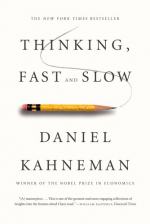
|
| Name: _________________________ | Period: ___________________ |
This quiz consists of 5 multiple choice and 5 short answer questions through Chapters 35 - 38.
Multiple Choice Questions
1. What neighborhood within Niagara Falls, New York was the location of a 70-acre landfill that was the epicenter of a massive environmental disaster?
(a) Almeda.
(b) Love Canal.
(c) Union City.
(d) Patterson.
2. Amos Tversky, Tom Gilovich, and Robert Vallone conducted a study of misperceptions and randomness in what sport?
(a) Basketball.
(b) Tennis.
(c) Football.
(d) Soccer.
3. In the presentation of the "character" of Tom W. in Chapter 14, what is the subject of the experiment asked to rate?
(a) What job Tom has.
(b) What Tom's major is in college.
(c) How old Tom is.
(d) At what age Tom gets married.
4. Cognitive strain is defined by the author as being affected by both the current level of effort and what?
(a) Cognitive Pupillometry.
(b) The presence of unmet demands.
(c) Levels of intelligence.
(d) The probability of future expectations.
5. Who wrote Strumbling to Happiness?
(a) Danny Oppenheimer.
(b) Daniel Gilbert.
(c) Larry Jacoby.
(d) Shane Frederick.
Short Answer Questions
1. Who created the Cognitive Reflection Test that involves the bat-and-ball problem along with two others?
2. In the author's description of the cold-pressor experiment, how long did the short episode consist of?
3. In the statistics presented by the author in the opening of Chapter 10, he states that instances of what disease are less prevalent in rural, sparsely populated counties largely in the Midwest, South, and the West?
4. What nineteenth-century British economist proposed the idea of a "hedonimeter"?
5. What psychologist described the pupil of the eye as a window to the soul in Scientific American?
|
This section contains 265 words (approx. 1 page at 300 words per page) |

|




